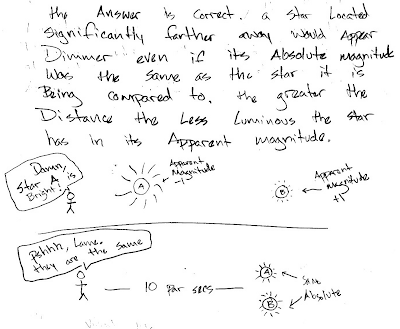Cuesta College, San Luis Obispo, CA
[20 points.] An astronomy question on an online discussion board(*) was asked and answered:
P-dog: Can a star with apparent magnitudes of +1, and a star with apparent magnitude –1 have the same absolute magnitude?Discuss why this answer is correct, and how you know this. Explain using the properties of apparent magnitude, absolute visual magnitude, and distance.
NoPlate: Yes, [if] the star with –1 [apparent] magnitude [is located] much closer...
*Adapted from: http://answers.yahoo.com/question/index?qid=20121105203518AAOq4ea.
Solution and grading rubric:
- p = 20/20:
Correct. Understands difference between apparent magnitude (m) values and absolute magnitude (MV) values, and that the two stars can have the same absolute magnitude (same brightness if both located 10 parsecs away) if the star that is actually closer seems bright (m = +1) and the star that is actually farther away seems dimmer (m = -1). - r = 16/20:
Nearly correct (explanation weak, unclear or only nearly complete); includes extraneous/tangential information; or has minor errors. - t = 12/20:
Contains right ideas, but discussion is unclear/incomplete or contains major errors. At least understands the difference between apparent (m) and absolute (MV) magnitudes, and that smaller positive (or more negative) magnitudes are brighter. - v = 8/20:
Limited relevant discussion of supporting evidence of at least some merit, but in an inconsistent or unclear manner. Garbled definitions/relations between d, m, and MV. - x = 4/20:
Implementation/application of ideas, but credit given for effort rather than merit. Discussion not based on apparent magnitudes, absolute magnitudes, and distances. - y = 2/20:
Irrelevant discussion/effectively blank. - z = 0/20:
Blank.
Section 70158
Exam code: midterm02s0Ur
p: 18 students
r: 1 student
t: 9 students
v: 5 students
x: 0 students
y: 0 students
z: 0 students
A sample "p" response (from student 0916):

No comments:
Post a Comment